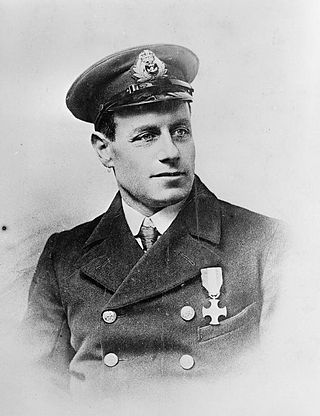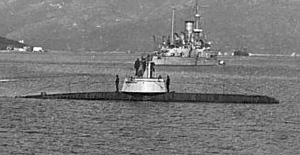
Seiner Majestät UB-4 was a German Type UB I submarine (U-boat) in the German Imperial Navy during World War I. She was sunk by a British Q-ship disguised as a fishing smack in August 1915.

Thomas Crisp VC, DSC, RNR was an English sailor and posthumous recipient of the Victoria Cross. Crisp, in civilian life a commercial fisherman operating from Lowestoft in Suffolk, earned his award after being killed during the defence of his vessel, the armed naval smack Nelson, in the North Sea against an attack from a German submarine in 1917.

A smack was a traditional fishing boat used off the coast of Britain and the Atlantic coast of America for most of the 19th century and, in small numbers, up to the Second World War. Many larger smacks were originally cutter-rigged sailing boats until about 1865, when smacks had become so large that cutter main booms were unhandy. The smaller smacks retained the gaff cutter rig. The larger smacks were lengthened and re-rigged and new ketch-rigged smacks were built, but boats varied from port to port. Some boats had a topsail on the mizzen mast, while others had a bowsprit carrying a jib.

SM UB-5 was a German Type UB I submarine or U-boat in the Imperial German Navy during World War I. She sank five ships during her career and was broken up in Germany in 1919.

The ST Leukos was an Irish commercial trawler that was sunk off the north coast of Ireland by a German U-boat on 9 March 1940. The vessel, which had been fishing in the company of British trawlers, was attacked by the German submarine U-38 off Tory Island. The submarine surfaced opening fire with its deck gun. All 11 crew members were lost.

SM UB-10 was a German Type UB I submarine or U-boat in the German Imperial Navy during World War I.
SM UB-12 was a German Type UB I submarine or U-boat in the German Imperial Navy during World War I. The submarine disappeared in August 1918.
SM UB-13 was a German Type UB I submarine or U-boat in the German Imperial Navy during World War I. The submarine was probably sunk by a British mine net in April 1916.

SM UB-16 was a German Type UB I submarine or U-boat in the German Imperial Navy during World War I. The submarine was sunk by a British submarine in May 1918.
SM UB-17 was a German Type UB I submarine or U-boat in the German Imperial Navy during World War I. The submarine disappeared during a patrol in March 1918.

SM UB-2 was a German Type UB I submarine or U-boat in the German Imperial Navy during World War I. She sank eleven ships during her career and was broken up in Germany in 1920.

SM UB-6 was a German Type UB I submarine or U-boat in the German Imperial Navy during World War I. The submarine was interned after running aground in neutral Dutch waters, and was scuttled by her crew at Hellevoetsluis.
SM UC-63 was a German Type UC II minelaying submarine or U-boat in the German Imperial Navy during World War I. The U-boat was ordered on 12 January 1916, laid down on 3 April 1916, and was launched on 6 January 1917. She was commissioned into the German Imperial Navy on 30 January 1917 as SM UC-63. In nine patrols UC-63 was credited with sinking 36 ships, either by torpedo or by mines laid. UC-63 was torpedoed and sunk by HMS E52 off Goodwin Sands on 1 November 1917; only one crewman survived the sinking.
His Majesty's or HM Armed Smack Inverlyon was a fishing smack that was converted to a Q-ship during the First World War. Q-ships served as decoys to lure German submarines near enough so that concealed weapons could be brought to bear and sink the submarines. On 15 August 1915, Inverlyon succeeded in luring German submarine UB-4 within range and sinking her with nine shots from her gun. The Royal Navy Gunner in command of the vessel, Ernest Martin Jehan, received the Distinguished Service Cross and members of Inverlyon's crew shared the bounty offered for German submarines. After Inverlyon's Q-ship career ended, she returned to fishing, but was sunk by U-55 on 1 February 1917.

The action of 15 August 1917 was a naval engagement which occurred during the First World War. The action was fought between a German U-boat and two naval trawlers, Nelson and Ethel & Millie, in the North Sea.
The Armed trawler Ethel & Millie was a British auxiliary warship which served during World War I. She was built in 1908 as the fishing smack Ethel & Millie, operating from Lowestoft and registered as LT 200. In early 1917 she was armed for defence against U-boat attack, and fought two actions against them. She was sunk in action on 15 August 1917.
HMS Penshurst was a Royal Navy warship that was active during World War I. She was a Special Service Vessel whose function was to act as a decoy, inviting attack by a U-boat in order to engage and destroy it. Penshurst fought a number of engagements against German U-boats during her service, and was successful on two occasions, destroying UB-19 in November 1916, and UB-37 in January 1917. Penshurst was sunk following an action with U-110 in December 1917.

Excelsior is an authentically restored fishing smack of the Lowestoft fishing fleet and a member of the National Historic Fleet. She was built by John Chambers of Lowestoft in 1921 and worked until 1936 before being converted into a motor coaster.
Caldew was a British steam fishing trawler. Launched in 1914 as Maristo, she was requisitioned by the Royal Navy for service in the First World War the following year. Maristo survived the war and resumed trawling for the next two decades, being renamed Caldew in that time. She collided with fellow trawler Ospray II in 1935, sinking the latter ship.









